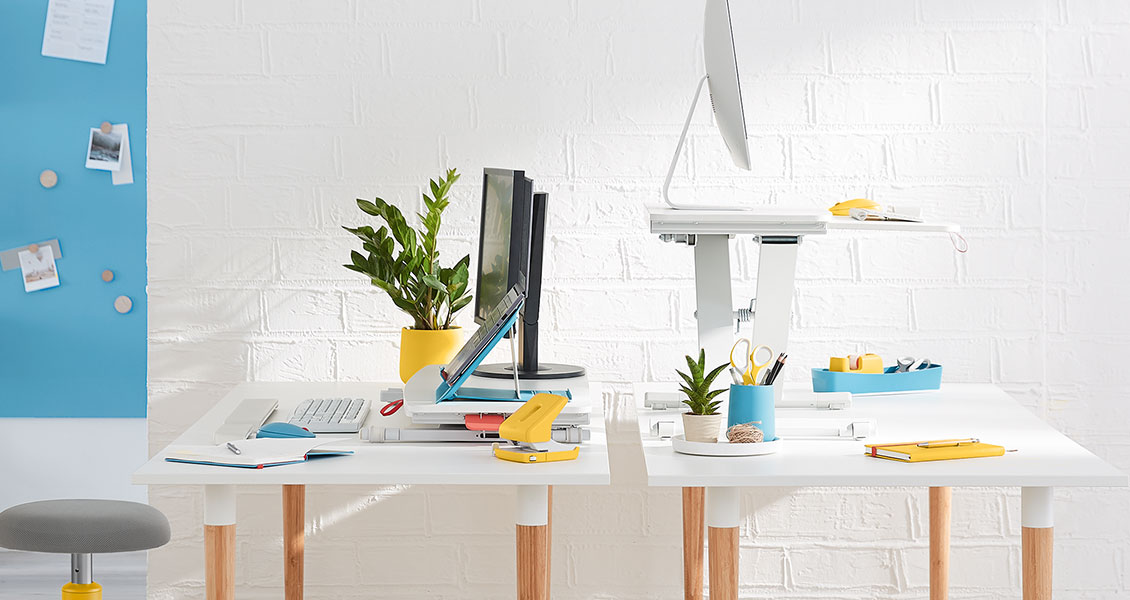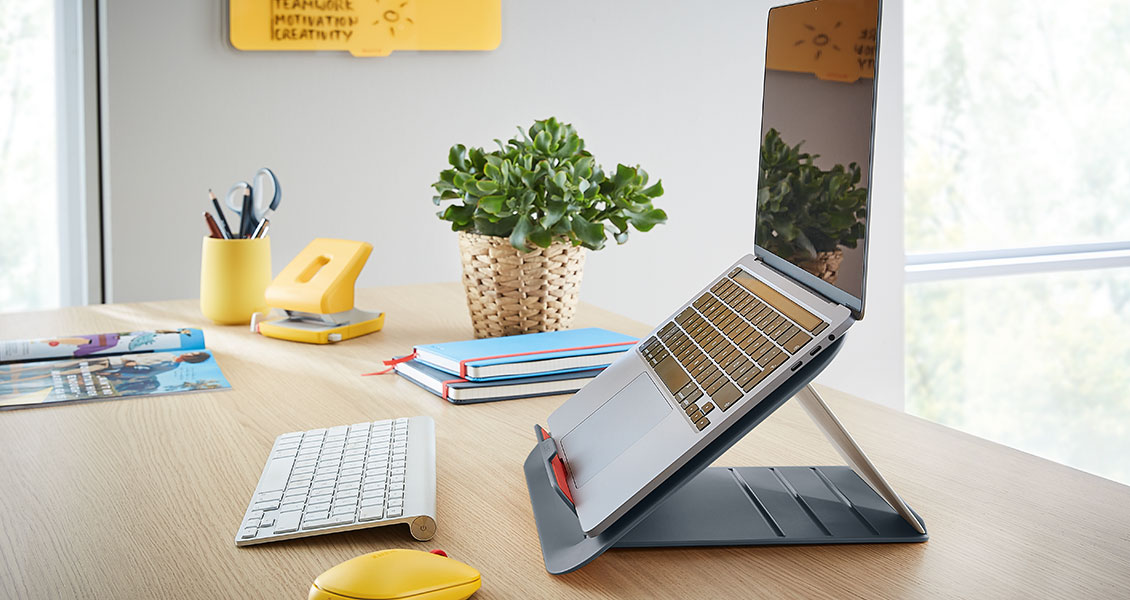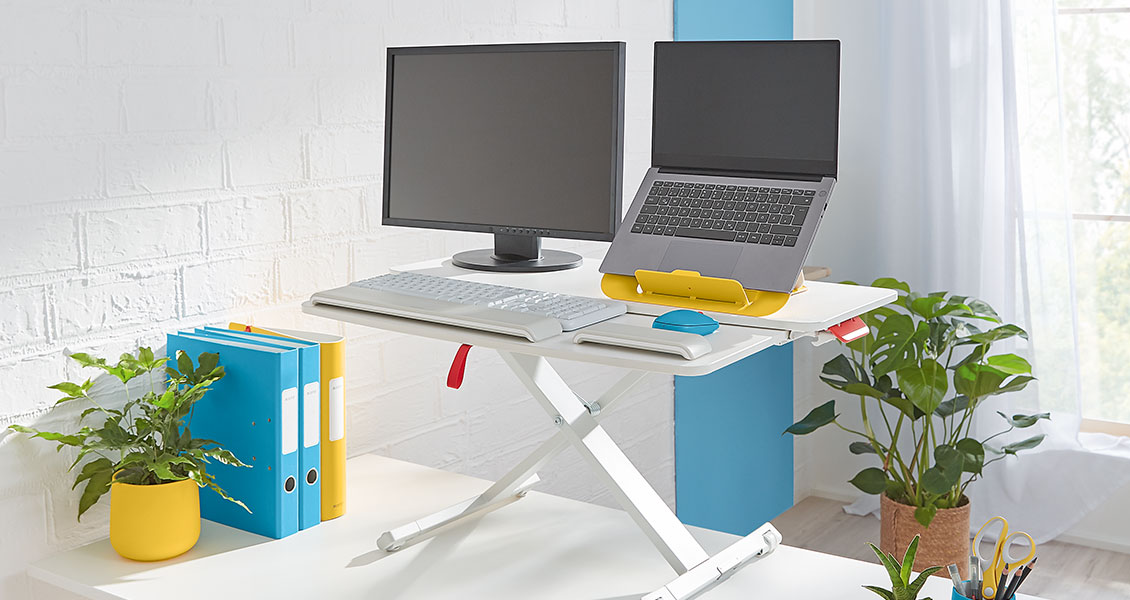What does Ergonomic Design Mean and Why is It Important?
30.06.2022

It’s vital that we use the right ergonomically designed equipment when we work. This applies to all sorts of jobs, including those who work at a desk in the office or whilst home working. Whilst we might think that injuries at work only concern those in more active jobs, office workers are also at risk. Using the wrong equipment, working in the wrong position, and remaining in one posture for too long can all cause harm to those who work at desks.
However, ergonomic equipment can help reduce this risk. But what exactly does ergonomic design mean, and why is it so important when setting up our workstations? Below, we investigate ergonomics and find out how we can utilise them for a safe and comfortable workplace.
What Does Ergonomic Design Mean?
Ergonomic design is applied to products and equipment that have been created to be interacted with efficiently and safely. In the workplace, ergonomic equipment is intended to boost people’s ability to work effectively whilst also reducing the risks of injury.
An ergonomic workstation will be designed to fit the person that is using it. That means that the user will be able to work comfortably, easily maintaining good posture, with minimal risk of harm. They will not have to exert any excess stress when they use the item; it should instead feel natural to use.

Good ergonomic office equipment will usually be adjustable, so it can be modified to fit the specific user. Everyone is built differently, so the best ergonomic equipment will allow for this. Adaptability is important for both home working, so you can find the right home office setup for your way of working, and in the office, especially where there might be hot desking. Adjustable ergonomic equipment means each user can change the equipment for their own use. This means that no one will have to work at a desk that has been ergonomically designed for someone else, which would likely result in injury.
Ergonomics is just one factor in design – the best office products will perfectly balance the ergonomics with aesthetics and functionality, to ensure the best tool for the job.
Why Ergonomic Design Is Important for Your Workstation
Whether you’re working from a home office or a corporate workplace, you should always implement ergonomic tools and equipment. This will reduce the need and likelihood of straining your muscles and joints, overusing certain muscle groups, and working for prolonged periods with poor posture.
Working without the right equipment or setup could result in injuries. These injuries can begin as small aches and pains but can develop into more serious problems if you continue to work with the incorrect equipment or setup. The types of health issues that can be caused by poor ergonomics include:
- Eye strain / issues with vision
- Pain or numbness in the hands and wrists
- Aches and pains in the neck, shoulders and back
- Tight or cramping muscles
- Stiff joints
- Other musculoskeletal disorders
The wrong equipment placed in the wrong location, working too long in one position, and working too quickly can all result in injuries. However, using the right ergonomics can go a long way in reducing the risk of injuries whilst working.
When you use the right ergonomic equipment, you will not only reduce the risk of long-term injuries, but you will also avoid fatigue. This will help you to stay focused and continue working productively and efficiently all day. However, it’s important that you still take regular breaks away from your desk, even when working with ergonomic equipment. This will support your body’s need to change position, give muscle groups a chance to rest and, just as importantly, give your mind an opportunity to rest, so you can come back refreshed.
How Can Ergonomics Be Utilised in Your Workstation?
There are a variety of ways you can incorporate ergonomic design into your workstation to minimise the risk of injury and keep you working comfortably and safely. This includes how you sit, the specific tools you use, where those tools are placed, and also the desk you use.
Ergonomic Office Chairs
When most people think of ergonomics in the workplace, their first thought will be office chairs. The chair you use to work is very important to working comfortably and safely. It should provide adequate lumbar support, whilst also keeping you at the correct height to view your monitors. Your seat should be at the correct height to keep your legs in a comfortable position with your feet flat on the floor, or you can use a foot rest if you need your chair to be higher. You can also use a seat cushion to further promote a good posture and keep you comfortable whilst you work.

Desk Ergonomics
Your workstation ergonomics shouldn’t stop at the chair you sit at. You should consider ergonomic design for all of your equipment.
Your monitors should be at the right height for you to view them easily without slouching or straining. A monitor stand or laptop riser can help to raise your screens so they’re at the correct height. Our monitor and laptop stands are adjustable, so you can find the perfect height that suits your needs.
Your arms and wrists should be held in a comfortable position, with your wrists straight and not at an angle. A keyboard wrist rest can help provide support whilst you type, keeping your wrists at the correct angle. You can also use a mousepad with a wrist rest to protect your wrists whilst you use your mouse. Your keyboard and mouse should both be in easy reach so you don’t have to stretch or strain to use them, as should your telephone and any other tools you frequently use throughout the day.

Sit Stand Desk
The most common workplace injuries are usually related to bad ergonomics and working in one position for too long, which causes strain on specific muscle groups. To combat this, a sit-stand desk allows you to alternate between sitting and standing, so no one muscle group is overworked or strained. Our standing desk converter allows you to easily change your workstation set up, effortlessly lifting or lowering to the height that you need. This will allow you to swap positions whenever you need, without taking up too much time as you adjust your setup. Plus, our sit-stand desk converter works within its own footprint, meaning you can save desk space and also don’t have to worry about rearranging your equipment every time you want to change to sitting or standing.
Leitz has a range of stylish and practical ergonomic office products to help keep your workplace safe, comfortable and productive.
Read more about ergonomics and staying safe whilst you work:
The Most Common Working from Home Injuries and How to Avoid Them
Quick Changes to Make to Your Workstation to Improve Ergonomics